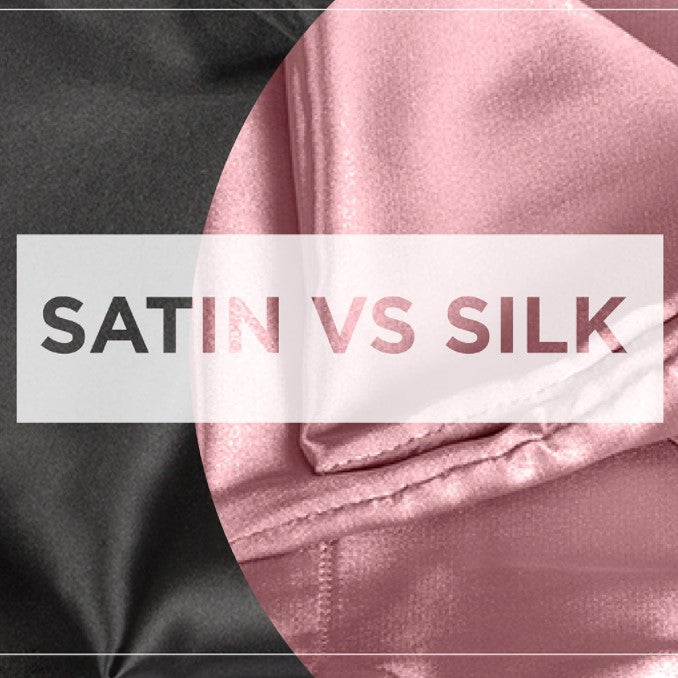365-DAY GUARANTEE | FREE SHIPPING | FREE RETURNS
365-DAY GUARANTEE | FREE SHIPPING | FREE RETURNS
365-DAY GUARANTEE | FREE SHIPPING | FREE RETURNS
April 23, 2021 5 min read
Even if you have been investing in high-end skincare products for getting smoother, radiant skin or long healthy locks but still you have not been seeing a drastic result. It’s time to change the material of your pillowcases. No amount of beauty sleep or products can help if you don’t have the right type of fabric for your pillowcases.
Silk and even satin pillowcases are trending nowadays for a reason. They possess such beauty and health properties that help with your frizzy hair and dull skin. Are you still wondering what makes satin or silk pillowcases stand out among the others? Keep reading!
Silk is a natural protein that is produced by a variety of insects like silkworms and it requires a lot of labor and their top-notch skills to extract, spin, and weave into real silk. As it is a naturally made animal protein fiber therefore it is quite skin-friendly. Each silk fiber is constructed from three to five of these silk filaments which are spun together to produce fabric in different types of weights. This is one of the most luxurious types of fabric.

Satin is not quite different from silk in its properties and glossy, sleek look. However, its production mainly makes it different from silk. Satin is a type of weaving that is now made from different kinds of synthetic fibers like rayon, polyester, and cotton although it used to be manufactured from silk in the old days.

Let’s do a short recap, silk is a natural fiber and it is mostly labor-intensive while satin is a synthetic type of weaving and it is capital-intensive.
If you are wondering whether a silk or satin pillowcase will be ideal for your skin and hair along with your high-end bohemian bedding. You need to consider a few differences:
Plenty of labor put their hard work, time, and effort to harvest the silk produced from silkworms that are later spun and weaved into fine quality silk fabrics. Whereas satin is produced in the factories by the use of synthetic materials and they are manufactured in generous quantities as plastic and recycled material is readily available in abundance as compared to silk.
If you’re unsure of the difference between silk and satin pillowcases particularly relating to softness, there’s a slight difference. Satin is quite slippery against the skin and you can feel the texture a bit while silk is incredibly soft with a flattering sheen and it glides against your skin without feeling its texture.
In the context of beauty, if you think cotton pillowcases for your boho pillows are doing good to your skin and hair like your cotton clothes, sorry to break it to you but you’re wrong. As cotton has moisture-wicking properties so it causes a lot of friction which in return makes your hair prone to breakage and causes your skin to develop fine lines and wrinkles. So, whether a satin or silk pillowcase for hair and skin is ideal? Let’s have a look:
As both satin and silk are soft to the touch, therefore, they prevent static electricity when you toss and turn during your deep night’s sleep and they help smooth out frizzy hair and give a beautiful shine to them.
Both silk and satin pillowcases don’t allow your brows and lashes to harshly rub against them as they don’t have a coarse texture. The soft and smooth texture simply glides over your face, therefore, keeps your eyelashes and brows luscious and healthy.
Unlike cotton pillowcases, sleeping on silk and satin pillowcases allows your skin to breathe and they don’t wick away moisture from your skin. This in return minimizes pores, reduces irritation and redness to keep your skin looking supple and even-toned.
With the addition of silk and satin pillowcases to your beauty routine, your skin will move without friction, thanks to the soft surface, that will help you to wake up in the morning without lines on your face caused by the pillow in the short-term and in the long-term, you will be keeping fine lines and wrinkles at bay.
As opposed to satin, silk is a natural fiber therefore it’s a very good thermal insulator, which means it maintains the temperature according to the weather. In winters, it will keep you warmer while in summers it will keep you cooler. This in return supports healthy skin. Silk is naturally hypoallergenic as well so it will prevent irritation and allergic reactions to your skin.
If you’re wondering which is better silk or satin pillowcases according to price, it depends on what you prioritize. As the process of harvesting and producing silk is very complex and labor-intensive and the supply is limited, therefore, it’s very expensive. Whereas, mulberry silk is the most expensive and highest quality of silk.
As polyester is easy to produce and the supply is not limited, therefore, satin pillowcases are not relatively expensive.
Although choosing between silk and satin may be slightly difficult for you but the following advantages may help you make the right decision:
If your budget doesn’t allow for silk, don’t fret! Satin has almost the same properties with additional benefits:
There are so many scammers out there that claim to sell real silk (which is actually blended) and you need to ensure that you don’t waste your money on such scams. Here are some tips to help you identify the real one:
Although silk and satin fabric are slightly different in terms of functionality to each other, the above-mentioned factors can also help you narrow down your choice to match your taste and preference. As there are many scammers out there so beware to do one of the tests mentioned above before purchasing real silk to ensure you’re not mis-sold.
